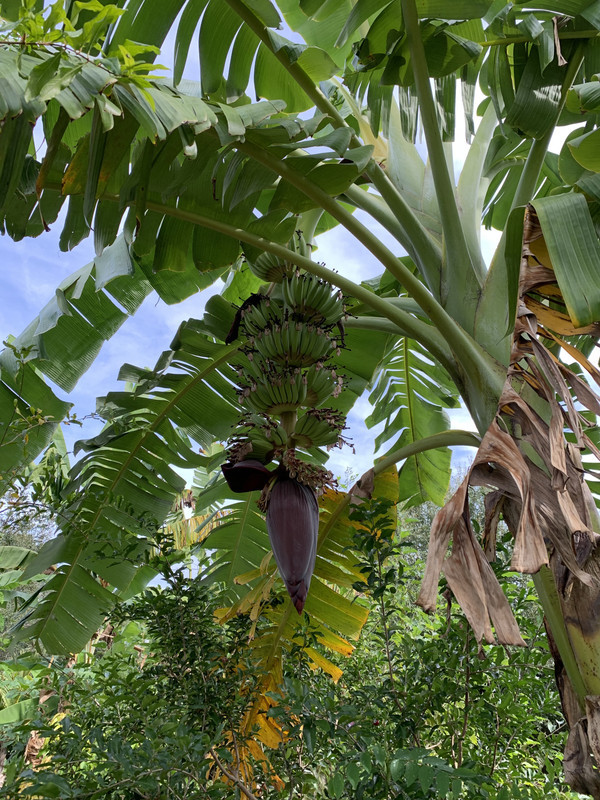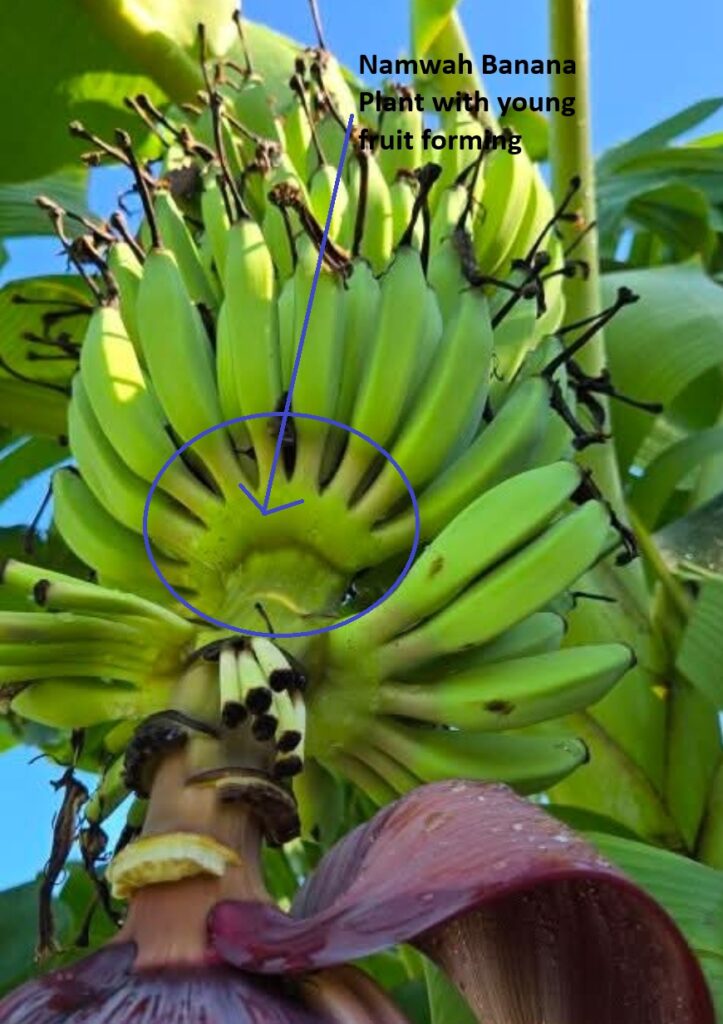S & J Nursery’s Guide to
Growing Namwah / Ice Cream Banana Plants
in Northeast Florida Gardens
 Blue Java / Ice Cream Banana Plants For Northeast Florida Gardens Origin:
Blue Java / Ice Cream Banana Plants For Northeast Florida Gardens Origin:

Banana plants are an herbaceous plant and although most commonly referred to as a tree as the “trunk” of the plant is a collection of the bases of the large banana leaf stalks.
They are native to Southeast Asia and have been cultivated and carried throughout the tropics and subtropical portions of the world for thousands of years. Namwah bananas are a Thai Banana Musa paradisica thought to be a wild cross of Musa acuminata and Musa bulbisiana.
Many Banana growers worldwide consider Namwah bananas to be the tastiest one available. They are sweet and creamy and lack the slight acidity of most of the lady finger type bananas. Each stem on a Namwah can produce 50 = lbs of fruits!
Note: there are two banana plants sold in Florida nurseries under the name of “ICE CREAM BANANA”. Many times plants labeled as Namwah / Ice Cream Banana ( pictured above ) are in fact once fruiting has taken place and plants can be properly identified are tall Namwah Ice cream Banana plants. The problem, if I were to take an educated guess at it seems to lie in the assumption that all plants being sold as “Ice Cream Banana” were Blue Java Banana plants. The tissue culture company in Florida that produces virus free banana starts has had both Blue Java Ice Cream (listed on their website and my invoice as Blue Java/ Ice Cream) those were the first ones I purchased with them, a few years later once ICE CREAM bananas were in high demand they had their listing just listed as Ice Cream and there were no blue java available. I believa at that point growers assumed the Ice Cream were the same Blue Java they had recieved before and marketed them as such. Then more recently they had listed Namwah bananas. Ive been growing with their starts for over 20 years and have watched the bananas carefully selecting for new cultivars worth attempting to grow in NE Florida. This is just, as a nurseryman, what I’ve seen occur in the Ice Cream Banana fruiting shenanigans over the last 10 years or so. It is pretty much understood in both the Nursery trade and on the banana enthusiast level at this point that if you haven’t seen your Blue Java or your Namwah fruit yet…you don’t really know which kind you have but it will be one of the two and only time will tell. Both fruits are desirable bananas for home production, the Blue Java in Florida landscapes tends to hold up a little better to our subtropical weather than the Namwah seems to in the majority of backyard gardens throughout the state but the Namwah seems to be preferred as far as taste goes. The true Blue Java banana plant fruit has a thicker texture.
How do I know which one of the ICE CREAM BANANAS I have in my home garden?
To easily tell the difference on the Blue Java vs the Namwah fruit ( surprisingly – color is not it, that blue can be very faint in reality and you often see doctored images of blue online ) is… once the fruits have started to enlarge… the Blue Java will have individual banana stems that are NOT FUSED together with the other bananas where the stem of the banana meets the fruit stalk. Namwah banana fingers will be fused together where the banana fingers in a hand of bananas meet the fruit stem from the plant. See images below.

Sun Exposure for the Namwah / Ice Cream Banana:
In Northeast Florida, bananas should be planted into a full sun or partial shade location preferably on the south side of the home and away from frost prone areas of the landscape.
Foliage of the Ice Cream Banana Tree / Plant:
Ice Cream banana plants are relatively cold tolerant and a good choice for the North East Florida landscape. The established banana plant can withstand temperatures down to 20 degrees for short periods of time and still regrow the next season from the underground corm. As with all Banana plants , temperatures below 32 for long periods of time can damage the stem and make the banana stem slow to grow and slower to produce fruit.
Foliage can be damaged by high winds in our subtropical climate zone, there is no need to remove them if they get ripped up and damaged and are still green, they are still photosynthesizing and feeding the banana plant. Once the leaf has browned out you can trim them off to maintain the neater appearance of the stems, but again its mostly for aesthetics just to keep them pretty.
Soil Preference for the Namwah Banana / Ice Cream Banana for Northeast Florida:
When it comes to planting banana’s in Northeast Florida I can not say this one thing enough, compost, compost and more compost! In fact the healthiest, best producing banana plants I have ever seen are growing right out of the compost pile on our tree farm in the Switzerland area of St. Johns county Florida.
Amend your soil generously with compost when planting banana plants. Dig your 3 ft by 3 ft hole or even bigger if you can, and back fill the area around your new banana plant with 50 percent compost and 50 percent native soil that you removed from the hole while digging.
Be sure to locate your banana in an area where it can receive supplemental irrigation and away from flood prone areas of your landscape. Banana’s need moist but well draining soils.
Size of the Namwah Banana / Ice Cream Banana Plant When Mature:
The mature size on a tall Namwah is 8 ft to the top of the stem. So the overall plant can reach 14 ft or more in height in height and 5-8 ft wide. There is also a dwarf Namwah banana / Pisang Awak with a slightly thicker and more compact pseudostem that can have pinkish red tones to the stems. Dwarf Namwah heights can range and are usually closer to the 6 ft to the top of the stem and the foliage above that in NE Florida’s sandy soils.
Pruning Namwah Bananas / Ice Cream Banana Plants for the Northeast Florida Landscape:
Banana plants form clumps by sending up suckers off the rhizome that forms underground. The main stem will die after flowering and forming fruits and the side shoots will replace it.
Prune out the center stem that has died and leave one to three well spaced stems that are directly connected to the main stem to grow up and replace it. Leaving to many suckers to grow will result in poor fruit production.
IMPORTANT: (Be careful not to leave water shoots (a sucker close to, but only superficially attached to the main stem)that will emerge at a distance from the main stem, these are not productive shoots and should always be removed, only keep shoots that are directly connected to the flowering base.)
Blooms and Fruit of Namwah Banana / Ice Cream Banana Plant for Northeast Florida Landscape:
Namwah Banana / Ice Cream banana plants are named for their smaller delicious fruits that are sweet, lack the bit of tang that comes with many of the lady finger varieties and have a creamy texture thus the common Ice Cream name. The Dwarf Namwah banana has a slightly thinner skin than the Tall Namwah Namwah banana that tends toward a thicker banana peel than most.
Water and Fertilizer Requirements of the Namwah Banana / Ice Cream Banana Plant:
Banana plants grow quickly and require allot of water and fertilizer to sustain that tremendous growth.
Water daily after planting your newly planted banana from and S & J Nursery container for the first two to three weeks being sure to supply your new plant all the water it can possibly need to get growing. Taper your water back to every other day then every third day then to once a week making sure to supply at least an inch to an inch and a half of water each week during the growing season.
The fertilizer recommendation varies depending on what professional you talk to, I guess we all have our opinions and what works best for us, we continue to use and recommend to others. Some recommend a fertilizer N-P-K ratio of 3-1-6 ( your fertilizer bag would say 6-2-12 or a similar ratio to 3-1-6) Others say to use a well balanced plant food keeping the N-P-K ratio at around 8-10-8. And then other garden authors say to use a 6-6-6 fertilizer.
One theme is constant among them all…fertilize frequently and heavily! Some recommend monthly some every other month, but all will tell you that bananas are heavy feeders and a mature banana plant may require as much as 1-2 lbs per application! Start with 1/4 of a lb on small plants and increase the amount applied monthly as the plant grows.
You may be able to locate a fertilizer formulated specifically for tropical plants or banana plants, I use composted manure and the leftover fruits and vegetable peels etc from kitchen scraps on mine and get good results.
Harvesting your Banana Plants Fruits:
Banana fruits mature slowly on the tree, some taking months after forming before the first hand begins to show any yellowing. When your unfamiliar with your particular banana plant varieties mature size and thickness a good rule of thumb when harvesting is to be sure to leave the fruit on the tree until you see the first hand of bananas start to show some color before removing them from the tree to allow them to finish ripening indoors. This again is personal preference with some people opting to harvest their banana trees one hand at a time allowing each one to fully ripen and removing each hand individually down the stalk while leaving the others on the tree to ripen slowly, this method extends the harvest a bit so in a plant that is a heavy producer this method may have merit.

